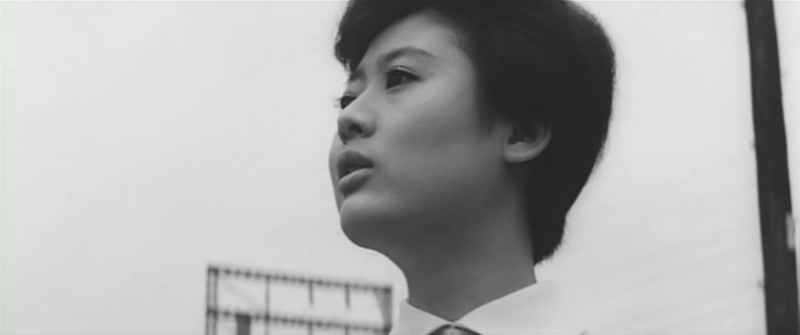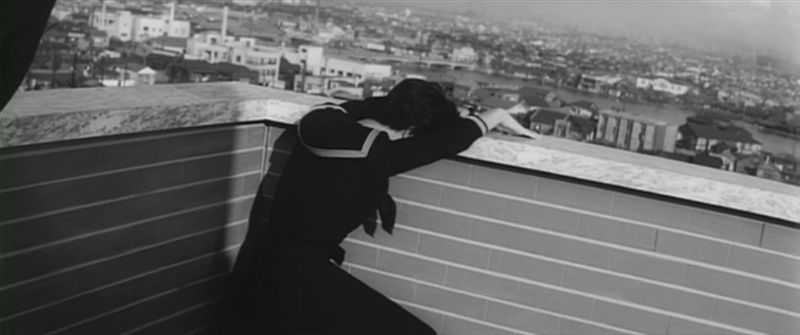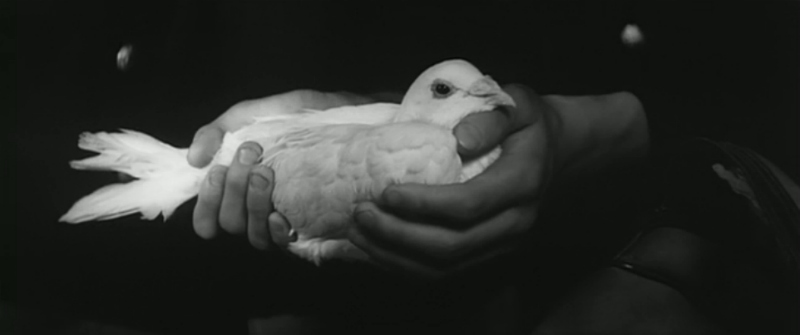
Stories dealing with poverty often rely on suggestion and intuition to get across the precise gravity of a character’s straits. Money is only as good as the time and place in which it exists, so for an audience viewing a work decades in the future, let alone in another country, we’re often forced to say “oh, well, they say they’re hungry, so that’s good enough.” Not so with Nagisa Oshima‘s near-debut (at 62 minutes, it could be called a feature, but still precedes his 96-minute Cruel Story of Youth). Following the introductory scene, we get a quick montage at the grocery store, informing us just how far Masao (Hiroshi Fujikawa) can get on the 700 yen for which just sold his pet pigeon. 10 yen for one egg. Sausage for 15. Cabbage on sale for 5. Money isn’t just a theoretical need in Oshima’s world, but has real, tangible, daily effects.
So when we find out that the pigeon-selling isn’t some last-ditch move resulting in Masao and his younger sister parting with a beloved pet, but actually a scheme his mother cooked up (birds inevitably escape from cages, and pigeons naturally fly home, and who would really be the wiser), we cringe, but also have tremendous sympathy for their plight. It’s one thing to be in such great need that you have to sell a pet; it’s another to have to sell it over and over. But with Mother sick, and unable to go shine shoes on the street, that’s exactly what they must do, especially if she is to help Masao climb out of their economic class and into high school, as she intends.

Luckily, she has some help. Masao’s schoolteacher, Miss Akiyama (Kakuko Chino), is extremely dedicated to kids like him, lobbying for a big electric plant to consider urban kids in their recruitment, and wouldn’t you know it, the girl to which he just sold that pigeon is the daughter of the company director. Kyoko (Yuki Tominaga) goes through the greatest transformation in the film, having the kind of eye-opening experience many middle- and upper-class kids have around that age, when “The Poor” stop being some other species, and their plight takes on a level of personal import. The difference here is that her motivations aren’t exclusively altruistic – she has a bit of a crush on Masao, and it wouldn’t do for her to go about with someone whose circumstances are so far removed from her own, for her family or for herself.
Cruel Story of Youth may be more explicit in its depiction of sex and lust, but A Street of Love and Hope displays the same sort of emotional volatility that seems, from the few films of his I’ve seen, common to Oshima. Yoko proves to be somewhat fickle, her desires escalating violently from one side to the next depending on who she feels is most immediately betraying her, regardless of the larger context in which those decisions were made. Masao, in turn, may have more on his mind than romance, but one can’t help but wonder the extent to which his desire for a better life is also a desire for a girl he’d otherwise be forbidden from seeing. Unfortunately, I didn’t get the sense that Oshima gave this as much consideration, and that could merely be something I drew from it.

On the whole, Masao is something of a cipher, fulfilling the role of “hard-working, upstanding poor boy,” and as the film’s conflict escalates, there is little doubt left as to just what Oshima is trying to say with this film. He introduces some interesting complexity by having Yoko’s brother, a company man himself, discriminate against Masao and his family, saying they’re probably cheating her with some sort of scheme, and end up correct, but, as the film posits ultimately posits, people will do what they must to survive, and it’s somewhat unfair to judge from a much loftier position. “A situation might arise where I’d sell my pigeons,” the schoolteacher states. “Or something similar. Something socially unacceptable but necessary to survive.” This hardly excuses Masao’s behavior – he’s quite conflicted about the whole endeavor himself – but it demonstrates that easy ways out are not easy decisions.
A Street of Love and Hope is available on Criterion’s Hulu channel in standard definition (sad face), but actually looks quite good for the limitations (happy face!). The picture is overall a little muddy, with slightly soft edges, but contrast is good, there’s no want for clarity, and it’s considerably better than a lot of what has passed for DVD transfers. Compression is minimal, or at least hidden amidst the overall picture quality, and the anamorphic image retains many of the pleasures of the format.

I can’t see this getting an official Criterion release – it’s too short, too minor a work – but it would make a wonderful supplement on another Oshima film (say, Cruel Story of Youth?), or certainly an Eclipse release full of his early work. Some sort of supplement examining to what extent class issues factored into his filmography would be nice, as well as interviews with any surviving cast members, if they can be found (Fujikawa, Tominaga, and Chino didn’t last long in the industry, but were young enough then that they may still be alive).
Until then, you can head on over to Criterion’s Hulu channel to check it out for yourself. I always try to call out these shorter, more minor films that are much less likely to see an official release as exemplary of what I love about Criterion’s Hulu channel, and this one, though hardly any kind of masterpiece, is a perfect example of a sharp, engaging film that would otherwise be swept under the rug.
To try Hulu Plus and get two weeks free, click here!
This is a 1959 short film Oshima made before embarking on A Street of Love and Hope, in the style of a trailer for an otherwise nonexistent film.



![Bergman Island (The Criterion Collection) [Blu-ray]](https://criterioncast.com/wp-content/uploads/2022/11/bergman-island-the-criterion-collection-blu-ray-400x496.jpg)
![This Is Not a Burial, It’s a Resurrection (The Criterion Collection) [Blu-ray]](https://criterioncast.com/wp-content/uploads/2022/11/this-is-not-a-burial-its-a-resurrection-the-criterion-collection-blu-ray-400x496.jpg)
![Lars von Trier's Europe Trilogy (The Criterion Collection) [The Element of Crime/Epidemic/Europa] [Blu-ray]](https://criterioncast.com/wp-content/uploads/2022/11/lars-von-triers-europe-trilogy-the-criterion-collection-the-element-of-400x496.jpg)
![Imitation of Life (The Criterion Collection) [Blu-ray]](https://criterioncast.com/wp-content/uploads/2022/11/imitation-of-life-the-criterion-collection-blu-ray-400x496.jpg)
![The Adventures of Baron Munchausen (The Criterion Collection) [4K UHD]](https://criterioncast.com/wp-content/uploads/2022/11/the-adventures-of-baron-munchausen-the-criterion-collection-4k-uhd-400x496.jpg)
![Cooley High [Criterion Collection] [Blu-ray] [1975]](https://criterioncast.com/wp-content/uploads/2022/11/cooley-high-criterion-collection-blu-ray-1975-400x496.jpg)